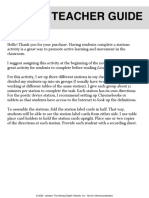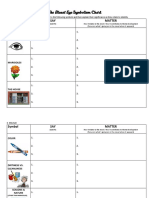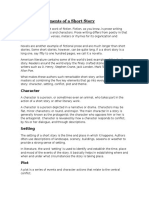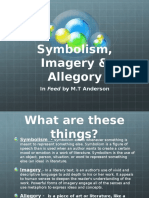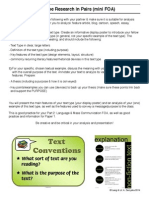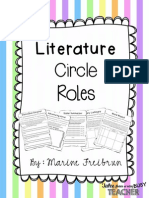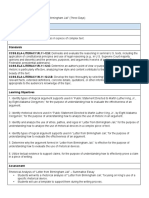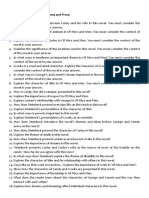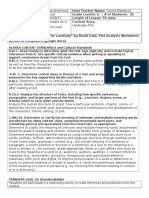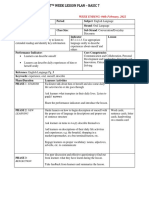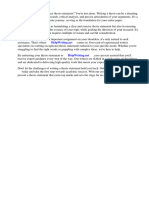Close Reading
Close Reading
Uploaded by
Anonymous nMdgq4Copyright:
Available Formats
Close Reading
Close Reading
Uploaded by
Anonymous nMdgq4Original Description:
Copyright
Available Formats
Share this document
Did you find this document useful?
Is this content inappropriate?
Copyright:
Available Formats
Close Reading
Close Reading
Uploaded by
Anonymous nMdgq4Copyright:
Available Formats
Close Reading
Close reading is a method of literary analysis which focuses on the specific details of a passage or text
in order to discern some deeper meaning present in it. The meaning derived from the close reading is
the reader’s interpretation of the passage or text.
Tip: There is no such thing as the one “true” meaning behind a text, so any
interpretation which can be supported by the text’s specific details is valid.
Don’t worry about arguing for the “correct” interpretation of a text or passage
and don’t be afraid to be creative in your analysis.
Close reading tends to rely on the principle that no details are present in a text by “accident.” The
author’s conscious intentions in writing are often insignificant, as unconscious layers of meaning or
even prejudices may be sublimated into literary works. Regardless of whether an author consciously or
unconsciously constructs a particular meaning in a text, if details are present which support that
interpretation, it is valid.
How to Begin a Close Reading
A close reading should never be your first reading of a text. Before focusing on the details of a text
or passage, it is important to have an understanding of the text as a whole.
Read the text!
Make sure that you understand its plot, who the characters are, etc. For more difficult texts, it
may take more than one read to do this. That is normal. The better your overall understanding
of the text, the easier it will be to focus on its details and/or the details of your chosen passage.
When you are ready to begin your close reading, take your time!
Read the text actively. Take notes. You may write on a separate sheet of paper, directly in your
book, or you may even choose to make a photocopy of the text or passage and take notes on
that. Choose the method which works best for you.
Do not be afraid to pause to think over what you read as you read!
Do not hesitate to read and re-read sentences or sections several times before moving on. Take
note not only of the details in the text, but also of the impressions which those details create in
you as a reader. The purpose of a close reading is to squeeze the details from your chosen text
and use those details to formulate an interpretation of a deeper meaning or impression present
in the text.
BCCC ASC Rev. 3/2019
Some Details to Consider When Reading Closely
Titles Matter!
Always take a moment to consider the title of your chosen text and its relationship to the content. The
author has chosen the title carefully to represent the text as a whole. Often, titles may point to important
symbols or images which you might then focus on more closely in your reading.
Example: In Nathaniel Hawthorne’s short story “The Birthmark” or Charlotte Perkins
Gilman’s short story “The Yellow Wallpaper,” the titles refer to prominent symbols
in the texts. Paying close attention to these symbols, how they are described,
and how they are treated in the texts would be fertile ground for a close reading.
Other titles may help to structure the reader’s understanding of the text’s content.
Example: Jamaica Kincaid’s short story “Girl” is a list of commands and instructions. The
text does not clearly state who these commands are directed towards, but the
title hints that they are commands for a specific girl, or perhaps girls in general.
Audience and Purpose
Who is the intended audience of the text or passage? What is its purpose? Audience and purpose may
help to contextualize some of the text’s details.
Example: In Jonathan Swift’s essay “A Modest Proposal,” he proposes that impoverished
Irish communities eat their children in order to limit their financial burdens and
gain a source of food.
Understanding Swift’s purpose, to use an absurd and morally reprehensible
argument to draw attention to the plights of these communities as well as to
criticize the faulty and rather callous logic employed by many English intellectuals
in discussing these issues, helps readers to understand his methods and the
significance of the way he lays out his hyper-rational and fairly horrifying
argument.
Narrative Point of View
The narrator is the voice through which the reader experiences the text. That means that all of the
information a reader receives is colored by the narrator’s perspective. Dissecting this perspective may
help to inform your understanding of how the text relates its information and how that dynamic
influences or constructs meaning within the text.
Is the text or passage narrated in 1st, 2nd, or 3rd person? Is the narrator omniscient (does he or she
know all of the characters’ thoughts and actions)? Is the narrator’s perspective limited to one
character’s experiences and thoughts? Is the narrator an impartial observer, a fly on the wall who
simply relates the events of the text or passage without giving insight into characters’ thoughts and
feelings?
Does the narrator seem to make any judgments regarding the characters or events of the text? Is the
narrator completely reliable? If the narrator may be biased, how does that influence the text? What
biases might the narrator possess? Is he or she possibly insane, lying, or mistaken?
BCCC ASC Rev. 3/2019
Example: Jamaica Kincaid’s short story “Girl” is narrated in 2nd person. This means that the
narrator seems to directly address the reader in his or her stream of commands
and instructions.
The reader may feel overwhelmed, defensive, or resentful of the narrator as a
result of the narrative point of view. Those feelings may mirror the feelings of a
girl who is being lectured regarding “proper” or “acceptable” behavior. Therefore,
the narration puts the reader in the position of the “Girl.”
What is the relationship between the narrator and the “Girl”/reader? How might
that be significant?
Imagery and Symbols
Often, a work of literature will emphasize a particular image. Images appeal to our senses, so a text
may include visual images, auditory images, images which involve smell, images which involve taste,
and images which involve touch.
What images do you find in the text or passage? Are there any images which appear to be emphasized
more than others? Why? How does that affect the meaning of the text or passage?
Some images may function as symbols in the text: images which have metaphorical meanings beyond
their literal meanings. Are there any symbols present in the text? What metaphorical meanings might
those symbols carry? If we accept those meanings, how does that influence our reading of the text?
Example: In Nathaniel Hawthorne’s short story “The Birthmark,” Georgiana, the
protagonist’s wife, has a birthmark on her face in the shape of a small hand. Her
husband sees this as an imperfection, which he then seeks to correct by
removing it. Georgiana dies during this process.
One way to interpret Georgiana’s birthmark is as a symbol of natural human
imperfection. If we accept this symbolic meaning, then how do we read
Georgiana’s death? Does the text seem to be commenting on the whether or not
human perfection is attainable?
Characterization
Who are the characters? Is there one protagonist (main character), in the text? Is there an antagonist (a
character or force which opposes the protagonist)? If so, how does the conflict influence the text?
Which characters are focused on and which characters are treated as secondary? How do we learn
about the characters? Does the narrator tell us about them explicitly through description? This is called
direct characterization. Do we learn about the characters through their actions and dialogue? This is
called indirect characterization. How does the characterization influence the meaning of the text or
passage?
Example: If you were to read a short story which characterized male characters primarily
through their actions, but female characters through descriptions given by a male
narrator, this might be evidence of gender bias in the text.
BCCC ASC Rev. 3/2019
Chronology
How is time treated in the text? Is it linear, a-linear? What span of time does it cover? Does it focus on
a period of minutes, hours, days, years? How do the choices about representing time influence or
construct meaning in the text?
Example: Toni Morrison’s short story “Recitatif” chooses to focus on short spans of time
spread across several decades in the lives of its two main characters.
What might the significance be of choosing those particular moments in the
characters’ lives to show to the reader? What do those moments have in
common? Why skip so much time in between passages? What effect does the
chronology of the text have on the reader’s experience of the narrative and the
characters?
Form
The literal form of a text can influence the reader’s experience of it. Some details related to form might
include line and paragraph breaks, the physical position of the text on the page, the font style, or even
something as simple as spacing.
Example: In concrete poetry, the words which make up the poem are manipulated to create
visual images on the page. George Herbert’s poem “Easter Wings” is physically
shaped like a pair of wings.
The overall form of the text is important, but so are breaks in form.
Example: Certain portions of Jamaica Kincaid’s short story “Girl” are italicized.
Why are these portions emphasized and separated from the rest of the text?
How does that affect the passage?
BCCC ASC Rev. 3/2019
Sentence Level: Diction (connotations), Syntax, and Punctuation
“Diction” refers to word choice. What types of words are used in the text or passage? Are the words
formal or informal, simple or complex, monosyllabic (short) or polysyllabic (long)? What do the words
physically sound like? Do the words carry any other connotations beyond their literal meanings which
may be relevant to your reading of the text?
Tip: Dictionaries such as the Oxford English Dictionary (OED) are useful resources in
determining a particular word’s history and connotations.
What do the sentences themselves look like? Are they simple or complex, long or short? Hemingway is
often praised for his simple, short sentences. How does the sentence structure influence your reading
of the text? What kinds of punctuation does the writer use?
Example: “Girl” happens to be a single, long sentence with many independent clauses
separated by semicolons.
What might the significance be of that choice? One interpretation is that reading
the sentence becomes overwhelming, which may mimic the feelings of a girl
being lectured about “proper” and “acceptable” behavior. Therefore, the sentence
structure helps the reader to sympathize with the title “character” of the short
story.
Patterns
What patterns are present in the text? Consider the significance of the pattern itself.
Example: In Theodore Roethke’s poem “My Papa’s Waltz,” the meter of the poem is
trimeter. This means that there are three beats in each line.
How might that pattern be significant to the text? Interestingly, a waltz is a dance
which follows a 1-2-3 pattern. Therefore, the pattern established by the meter
seems to mimic the dance which is mentioned in the poem’s title. This has the
effect of emphasizing the “waltzing” of the boy and his father in the poem. How is
that important to the poem’s overall meaning?
Is the pattern established in the text ever interrupted? Interruptions or breaks in firmly established
textual patterns are usually particularly significant. Remember that the author has gone to a lot of
trouble to establish this pattern in the text. If he or she is choosing to disrupt it, there is probably a very
good reason.
Example: In “My Papa’s Waltz,” there are occasional breaks in the meter.
Why is this significant? If the “waltz” of the poem is imperfect, does it suggest
something about the boy, his father, and/or their relationship?
Contradictions/Inconsistencies
Like breaks in patterns, inconsistencies or contradictions in the text are also particularly worthy of
attention. What inconsistencies or contradictions can you identify? What are the sources of these
contradictions?
BCCC ASC Rev. 3/2019
Is there an unreliable narrator? What is unreliable about this person? Are different characters’
perspectives the source of the contradiction? What is the effect or utility of reinforcing the differing
perspectives of these characters? Does the text seem to be purposely confusing or contradictory?
What might the significance of that be?
Example: In “Recitatif,” Twyla and Roberta, the short story’s co-protagonists, remember
some of the events of their shared childhood differently.
What is the overall significance of this inconsistency in their memories? Is Toni
Morrison attempting to make a comment about memory itself? Is she trying to
call attention to the differences in the characters’ perspectives? Why might that
be important?
Allusions
Allusions are references to knowledge or events outside of the text itself, often other literary works, but
sometimes current events or politics. Are there any allusions present in the text or passage? To what
do they refer?
If the text establishes a connection to another text through an allusion, then how does a reading of the
second text influence your understanding of the first text? In western literature, direct allusions to
biblical stories can be common. However, some allusions are very subtle and even unexpected.
Example: Disney’s The Lion King features a young prince whose father is killed by his
uncle, the king’s own brother. When the prince grows up, he must then make a
decision about whether or not to challenge his uncle for the throne.
The plot of The Lion King can be read as a subtle reference to Shakespeare’s
play Hamlet, whose plot follows a similar pattern. In this particular example,
examining the similarities between the two stories as well as the differences and
deliberate changes which Disney has made to the Hamlet tale would be valuable
to your critical understanding of the film.
It may also be helpful to consider the significance of a modern children’s film
borrowing plot from an early modern Shakespearean play, since the two do not
appear to have similar audiences or contexts at first glance.
Research Anything Unfamiliar!
A quick online search (or inquiry to your tutor or professor!) for anything unfamiliar in the text or
passage can point you to allusions or other connections which you would not have made.
Example: In reading the poem “My Papa’s Waltz,” you may not have known that a waltz is
a three beat dance. However, by doing a small bit of research on “waltz,” one of
the key words in the poem’s title, you might find this information. Then, you might
realize the connection between the dance and the meter of the poem itself.
BCCC ASC Rev. 3/2019
Some Tips for Writing Essays Using Close Reading
Like all literary analysis, close reading should produce interpretations of the text which are
debatable rather than factual. This is the difference between an interpretive claim and a claim
which simply relates a detail of the text. For an essay which uses close reading, the
interpretation of the text will usually be stated in the essay’s thesis.
Example: Pointing out that Twyla and Roberta, the co-protagonists of Toni
Morrison’s short story “Recitatif” are described as being of different racial
backgrounds, one African American and one Caucasian, but that the text
never specifies which character is of which racial background, is an
example of a factual claim pointing out certain specific details of the text.
An interpretive claim which would be supported by those details is that
“Recitatif” challenges the racialized assumptions of its readers by tricking
them into attempting to figure out which character is of which racial
background and by giving them only stereotypes as evidence to support
their deductions.
The latter claim, since it is debatable rather than factual, would be a
stronger, interpretive thesis statement for an essay.
Because close reading focuses on the details of the text or passage and how they work together
to create meaning, it is especially important to support all claims about the text with specific
examples from the text in the form of quotation or cited paraphrase. Quotations are preferable
whenever possible because of their specificity. Close reading essays which are effective should
contain a large proportion of quotations. However, it is also important to remember to connect
all of those details to your central thesis.
Example: If you are writing an essay about “Recitatif” using the aforementioned
thesis, you may choose to quote the blocks of text which describe the
characters.
It is important not only to quote these passages, but also to explain how
they fail to provide specific details regarding the characters’ racial
identities, how the text tempts readers to make certain assumptions about
the characters’ racial identities with some details, and how it tempts the
reader to make opposite assumptions in other sections of the text. Then,
you would tie this analysis back to your thesis statement by explaining
how specifically tempting the reader with contradictory assumptions about
the characters’ racial identities might serve to challenge the reader’s own
racialized assumptions.
In writing your essay, once you have formed a preliminary thesis statement, it is not necessary
to dissect every single specific detail of your chosen text or passage in your writing. Focus only
on those details whose analysis will best support your thesis. Some essays will include
discussions of a variety of textual details, while others may focus on only a few. Some details
may not be relevant to your argument. Those details are not necessary to include and may
actually detract from your writing.
Example: In an analysis of Ernest Hemingway’s short story “Hills Like White
Elephants” which focuses on the symbolism of the hills themselves, the
physical form of the text on the page is likely irrelevant.
BCCC ASC Rev. 3/2019
You might also like
- Respostas Homework Cna Inter 2Document5 pagesRespostas Homework Cna Inter 2h4a0nawc100% (1)
- Narnia Essay NotesDocument12 pagesNarnia Essay NotesbouliayNo ratings yet
- Coyote and The Buffalo Student TextDocument8 pagesCoyote and The Buffalo Student Textapi-516330412No ratings yet
- The Handmaids Tale Lesson PlanDocument8 pagesThe Handmaids Tale Lesson PlanNehal Ezz El-Dein0% (1)
- Homegoing EssayDocument5 pagesHomegoing Essayapi-615884217No ratings yet
- AnalysisDocument4 pagesAnalysissyz1eNo ratings yet
- Writing Unseen Commentaries - WordSmith 2007Document181 pagesWriting Unseen Commentaries - WordSmith 2007Abdulahi MaxamedNo ratings yet
- Elements of An AutobiographyDocument1 pageElements of An AutobiographySergio GonzalesNo ratings yet
- Article WritingDocument2 pagesArticle WritingJobin Devasia75% (4)
- Major Genres of The 21ST Century LitertatureDocument32 pagesMajor Genres of The 21ST Century LitertatureJustine Hail GregorioNo ratings yet
- 6 Word Memoir RubricDocument1 page6 Word Memoir RubricKatie MadsenNo ratings yet
- Year 8 Unreliable Narrators - Creative Writing UbdDocument18 pagesYear 8 Unreliable Narrators - Creative Writing Ubdapi-313814787No ratings yet
- Secondary Unit Plan - Romeo and JulietDocument2 pagesSecondary Unit Plan - Romeo and Julietapi-240694323No ratings yet
- AnalysisoffromblossomsDocument4 pagesAnalysisoffromblossomsapi-316834697No ratings yet
- Stage 6 English Advanced Year 12 Common Module Sample UnitDocument21 pagesStage 6 English Advanced Year 12 Common Module Sample UnithelenNo ratings yet
- War Poetry Assignment SheetDocument4 pagesWar Poetry Assignment Sheetapi-249815522100% (1)
- Essay HarwoodDocument2 pagesEssay HarwoodMATTHEW TANG0% (1)
- Ib Language & Literature: HL EssayDocument17 pagesIb Language & Literature: HL Essayapi-520941535100% (1)
- Analysing PoemsDocument2 pagesAnalysing Poemsjehnee88100% (1)
- Sophocles' Antigone - Student Guided NotesDocument16 pagesSophocles' Antigone - Student Guided NotesMegan PittmanNo ratings yet
- Pedro Paramo Ghost QuoteDocument1 pagePedro Paramo Ghost QuotelzeeNo ratings yet
- Teacher Guide: Zacchris NajacobaubreyDocument10 pagesTeacher Guide: Zacchris NajacobaubreyAustin/KenzieNo ratings yet
- Fahrenheit 451: by Ray BradburyDocument12 pagesFahrenheit 451: by Ray BradburyDaniel HalaszNo ratings yet
- The Bluest Eye Symbolism ChartDocument2 pagesThe Bluest Eye Symbolism Chartapi-260339450No ratings yet
- Macbeth UnitDocument22 pagesMacbeth Unitapi-213500835No ratings yet
- Elizabeth BishopDocument7 pagesElizabeth Bishopapi-327726527No ratings yet
- Language - and - Literature SGODocument15 pagesLanguage - and - Literature SGOmayaNo ratings yet
- English 11 Course Outline 2013Document3 pagesEnglish 11 Course Outline 2013api-54282398No ratings yet
- HTTPS://WWW - Scribd.com/book/251488602/montana 1948 A NovelDocument4 pagesHTTPS://WWW - Scribd.com/book/251488602/montana 1948 A NovelNicholas SpicerNo ratings yet
- Steps To Analysing A Short StoryDocument17 pagesSteps To Analysing A Short StorySher ElliottNo ratings yet
- Elements Short StoryDocument3 pagesElements Short Storylourdes0% (1)
- I Want A Wife by Judy Brady Annotated EssayDocument2 pagesI Want A Wife by Judy Brady Annotated Essayapi-534927197100% (1)
- Symbolism in FeedDocument12 pagesSymbolism in Feedapi-2707270830% (1)
- Poetic Devices Worksheetwith ExamplesDocument2 pagesPoetic Devices Worksheetwith ExamplesGinalynJandaQuiñonesNo ratings yet
- Lorna Goodison QuestionsDocument2 pagesLorna Goodison QuestionsDricNo ratings yet
- To Kill A Mockingbird Censorship and BansDocument1 pageTo Kill A Mockingbird Censorship and BansMarcusFelsmanNo ratings yet
- Text Type Intro Presentation TaskDocument1 pageText Type Intro Presentation Taskapi-262266786100% (1)
- Subject English Language Arts Grade 10-2 Topic/Theme Poetry & Short Stories Length (Days) 28Document28 pagesSubject English Language Arts Grade 10-2 Topic/Theme Poetry & Short Stories Length (Days) 28api-340960709No ratings yet
- Updated Literature Circle Roles 2015Document13 pagesUpdated Literature Circle Roles 2015api-270337113No ratings yet
- Hamlet Literature UnitDocument5 pagesHamlet Literature Unitapi-347882880No ratings yet
- Sample Plan - Letter From Birmingham JailDocument11 pagesSample Plan - Letter From Birmingham Jailapi-305114866100% (1)
- The Official English Handbook For AP Poetry Terms Bring This To Class EVERY DAY!!!!!!!!!!!!!!!!!!!!!!!!!!!Document9 pagesThe Official English Handbook For AP Poetry Terms Bring This To Class EVERY DAY!!!!!!!!!!!!!!!!!!!!!!!!!!!ronanNo ratings yet
- Literary DevicesDocument23 pagesLiterary DevicesAsh PaiceNo ratings yet
- Literary DevicesDocument7 pagesLiterary DevicesArgie Ray Ansino ButalidNo ratings yet
- Of Mice and Men (4ET1 Esssay Questions)Document2 pagesOf Mice and Men (4ET1 Esssay Questions)M M100% (1)
- Part 2 - The Things They CarriedDocument6 pagesPart 2 - The Things They Carriedapi-325234593No ratings yet
- Literary DevicesDocument7 pagesLiterary Deviceskellyting90No ratings yet
- A Study Guide for John Keats's "When I Have Fears That I May Cease to Be"From EverandA Study Guide for John Keats's "When I Have Fears That I May Cease to Be"No ratings yet
- A Cottage in The LaneDocument3 pagesA Cottage in The LaneShafay SheikhNo ratings yet
- Medusa PresentationDocument7 pagesMedusa PresentationLe Sneaky SnaccNo ratings yet
- Unit Planner Understanding Poetry Unit 2, Grade 8 Q-1 AliDocument7 pagesUnit Planner Understanding Poetry Unit 2, Grade 8 Q-1 AliAli Al ShehabNo ratings yet
- Things Fall Apart - StudentDocument76 pagesThings Fall Apart - Studenthghghghb100% (2)
- LaBudaCJ-TheVeldt Lesson Plan 7th GradeDocument9 pagesLaBudaCJ-TheVeldt Lesson Plan 7th Gradecarolynls55No ratings yet
- SoapstoneDocument1 pageSoapstoneapi-371063448No ratings yet
- Jaime Estrada Final BelovedDocument54 pagesJaime Estrada Final BelovedJaime_Marie_EstradaNo ratings yet
- Satire Fable AllegoryDocument3 pagesSatire Fable AllegoryLucy HernandezNo ratings yet
- The Things They Carried WritingDocument2 pagesThe Things They Carried Writingapi-246870763No ratings yet
- Grammar 10th 3 TermDocument24 pagesGrammar 10th 3 TermGonzalez YinaNo ratings yet
- Class 1 and 2 - What Is LiteratureDocument33 pagesClass 1 and 2 - What Is LiteraturemakaNo ratings yet
- VCE Argument Analysis Structure and Template Art of Smart EducationDocument4 pagesVCE Argument Analysis Structure and Template Art of Smart EducationBijila Biju JayakumariNo ratings yet
- Landlady LessonDocument5 pagesLandlady Lessonapi-351587400No ratings yet
- A Study Guide for Sandra Cisneros's "My Lucy Friend Who Smells Like Corn"From EverandA Study Guide for Sandra Cisneros's "My Lucy Friend Who Smells Like Corn"No ratings yet
- MCQs on Expositoring Writing 1Document13 pagesMCQs on Expositoring Writing 1subhanaliofficial07No ratings yet
- Camden County College, Fall 2017: English Composition 1Document13 pagesCamden County College, Fall 2017: English Composition 1health worldNo ratings yet
- WRI 102 Sythnthesized Research Argument Essay: Outline Style # 2Document8 pagesWRI 102 Sythnthesized Research Argument Essay: Outline Style # 2OwenNo ratings yet
- Mission General TB PDFDocument21 pagesMission General TB PDFRiswanNo ratings yet
- Writing 1Document33 pagesWriting 1unknown5567kNo ratings yet
- Demonic Possession and Exorcism Klingenberg CaseDocument51 pagesDemonic Possession and Exorcism Klingenberg CaseGabriel David LievanoNo ratings yet
- JHS 1 Eng WK7Document5 pagesJHS 1 Eng WK7Naomi TettehNo ratings yet
- Silent Dancing EssayDocument3 pagesSilent Dancing Essayzzcpllaeg100% (3)
- Informal Outlines: Sentence EssayDocument6 pagesInformal Outlines: Sentence EssayKhryss AnthonyNo ratings yet
- Master Thesis Design PatternsDocument7 pagesMaster Thesis Design Patternsbsq1j65w100% (2)
- Global Climate Change Death Penalty ElectionDocument10 pagesGlobal Climate Change Death Penalty ElectionAar Tech CareNo ratings yet
- 3121an Introduction To The Study of Literature (Chapter - 1)Document13 pages3121an Introduction To The Study of Literature (Chapter - 1)Anonymous b94YkwkV5k75% (20)
- Essay On My Dream JobDocument4 pagesEssay On My Dream Jobxlfbsuwhd100% (2)
- Transcendence EssayDocument3 pagesTranscendence Essayapi-318242872No ratings yet
- Rate My Thesis StatementDocument7 pagesRate My Thesis Statementfd0kyjpa100% (1)
- Writing Skills: A Personal Narrative: Graded ProjectDocument21 pagesWriting Skills: A Personal Narrative: Graded ProjectMwithuxs FeniNo ratings yet
- Should Same Sex Marriage Be Legalized EssayDocument3 pagesShould Same Sex Marriage Be Legalized Essayedrgnvwhd100% (2)
- Streetcar Named Desire Final Project ActvityDocument11 pagesStreetcar Named Desire Final Project Actvityapi-253866947No ratings yet
- English 1301 Reflection EssayDocument6 pagesEnglish 1301 Reflection Essayapi-581866115No ratings yet
- Essays That Will Get You Into Law School (PDFDrive)Document256 pagesEssays That Will Get You Into Law School (PDFDrive)minh ngọcNo ratings yet
- EAPP Quiz 1Document11 pagesEAPP Quiz 1VeranelleNo ratings yet
- Unit: Heroes: By: Kyle Fleet Grade Level: High School RationaleDocument19 pagesUnit: Heroes: By: Kyle Fleet Grade Level: High School RationalePınar Çalış100% (1)
- Fiba - Samahang Basketbol NG Pilipinas (SBP)Document16 pagesFiba - Samahang Basketbol NG Pilipinas (SBP)kylie martinezNo ratings yet
- How To Write A Critical Analysis EssayDocument2 pagesHow To Write A Critical Analysis Essayxqqryvwhd100% (2)
- Literary Devices ThesisDocument8 pagesLiterary Devices Thesisafknbiwol100% (2)
- Thesis Statement About ApolloDocument7 pagesThesis Statement About Apollogjh9pq2a100% (2)
- Terry Fox Thesis StatementDocument4 pagesTerry Fox Thesis Statementgjgwmp01100% (2)
- Research ProcessDocument13 pagesResearch ProcessYogesh GargNo ratings yet





















